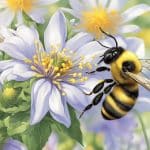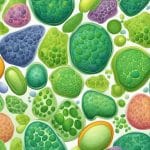Types Of Fungi
Fungi are a diverse group of organisms that play a crucial role in the ecosystem. They are eukaryotic organisms that belong to the kingdom Fungi, which includes yeasts, molds, mildews, and mushrooms. Fungi are found in almost every environment on Earth and play a vital role in decomposing dead organic matter, recycling nutrients, and helping plants grow.
Fungal classification and phyla are essential to understanding the different types of fungi. There are over 100,000 known species of fungi, and they are classified based on their morphology, mode of reproduction, and ecological role. The five major phyla of fungi are Chytridiomycota, Zygomycota, Ascomycota, Basidiomycota, and Glomeromycota. Each phylum has unique characteristics and plays a vital role in the ecosystem.
Key Takeaways
- Fungi are eukaryotic organisms that belong to the kingdom Fungi and play a crucial role in the ecosystem.
- The five major phyla of fungi are Chytridiomycota, Zygomycota, Ascomycota, Basidiomycota, and Glomeromycota, each with unique characteristics and ecological roles.
- Understanding fungal biology and life cycle, their impact on ecosystems and human life, and their pathogenic potential is essential for research and study of fungi.
Fungal Classification and Phyla

Fungi are a diverse group of organisms that are classified into different phyla based on their unique characteristics. The classification of fungi has undergone significant changes since the 1990s, leading to the current classification system that divides fungi into seven phyla, ten subphyla, 35 classes, 12 subclasses, and 129 orders.
Chytridiomycota and Their Traits
Chytridiomycota is one of the five true phyla of fungi. They are characterized by their unique flagellated spores, which allow them to move through water. Chytrids are found in a variety of environments, from freshwater to soil. They have a simple body structure, with a single cell wall made of chitin. Chytridiomycota are known to cause diseases in plants and animals, including the worldwide decline in amphibian populations.
Zygomycota and Bread Molds
Zygomycota, also known as conjugated fungi, are characterized by their ability to form zygosporangia during ual reproduction. These fungi are commonly found in soil and decaying plant matter. Bread molds, such as Rhizopus stolonifer, belong to this phylum. They reproduce aually through the production of spores and can cause food spoilage.
Glomeromycota and Mycorrhizae
Glomeromycota is the most recently described phylum of fungi. They are characterized by their ability to form arbuscular mycorrhizae, a symbiotic relationship with plant roots. These fungi help plants absorb nutrients from the soil and protect them from pathogens. Glomeromycota are found in a variety of environments, from deserts to forests.
Ascomycota: The Sac Fungi
Ascomycota is the largest phylum of fungi and comprises roughly two-thirds of all described species. They are characterized by their production of sac-like structures called asci during ual reproduction. Ascomycota are found in a variety of environments, from freshwater to soil. They are known to cause diseases in plants and animals, including human infections such as athlete’s foot and ringworm.
Basidiomycota: Club Fungi
Basidiomycota, also known as club fungi, are characterized by their production of club-shaped structures called basidia during ual reproduction. They are found in a variety of environments, from forests to grasslands. Basidiomycota are known to cause diseases in plants and animals, including the rusts and smuts that affect cereal crops.
In conclusion, the classification of fungi is based on their unique characteristics, including cell wall composition, reproductive structures, and ecological roles. The seven phyla of fungi, including Chytridiomycota, Zygomycota, Glomeromycota, Ascomycota, and Basidiomycota, represent the diversity of this fascinating group of organisms.
Fungal Biology and Life Cycle
Fungi are eukaryotic organisms that are found in almost every habitat on earth. They are classified into different groups based on their morphology, physiology, and genetic makeup. The life cycle of fungi is characterized by a series of events that involve the production and dispersal of spores, the formation of hyphae and mycelium, and the alternation of haploid and diploid stages.
Hyphae and Mycelium Structure
Hyphae are the basic building blocks of fungi. They are long, thin, and filamentous structures that grow in a branching pattern to form a network of interconnected tubes called mycelium. The mycelium is the vegetative part of the fungus and is responsible for absorbing nutrients from the environment. The hyphae have a tubular structure that allows them to secrete digestive enzymes and absorb nutrients from the surroundings.
Reproductive Strategies
Fungi employ different reproductive strategies depending on the species and environmental conditions. ual reproduction involves the fusion of haploid nuclei from two different mating types to form a diploid zygote. The zygote undergoes meiosis to produce haploid spores that can disperse and germinate to form new individuals.
Spore Formation and Dispersal
Spores are the primary means of reproduction in fungi. They are produced in specialized structures such as asci and basidia, which are found in different groups of fungi. Asci are sac-like structures that contain ascospores, while basidia are club-shaped structures that produce basidiospores. The spores are dispersed by various mechanisms such as wind, water, and animals.
In conclusion, the life cycle of fungi is complex and involves the production and dispersal of spores, the formation of hyphae and mycelium, and the alternation of haploid and diploid stages. Fungi employ different reproductive strategies depending on the species and environmental conditions. The spores are the primary means of reproduction and are dispersed by various mechanisms such as wind, water, and animals.
Fungi in Ecosystems and Human Life
Fungi play a vital role in ecosystems and human life. They are ubiquitous and diverse, with over 144,000 known species. In this section, we will explore some of the ways fungi impact the world around us.
Decomposers and Nutrient Cycling
Fungi are key decomposers in ecosystems, breaking down dead organic matter and recycling nutrients back into the soil. This process is critical for maintaining healthy soil and supporting plant growth. Some fungi are saprobes, which means they obtain their nutrients from dead organic matter. Others are mycorrhizal, forming symbiotic relationships with plants and exchanging nutrients for carbohydrates.
Symbiotic Relationships with Plants
Mycorrhizal fungi form mutualistic relationships with plants, helping them absorb nutrients from the soil and providing protection against pathogens. In return, the plants provide the fungi with carbohydrates. Lichens are another example of a symbiotic relationship between fungi and plants. In this case, the fungi form a partnership with algae or cyanobacteria to create a unique organism that can survive in extreme environments.
Fungi in Industry and Medicine
Fungi have a wide range of industrial and medical applications. Yeasts, for example, are used in baking and brewing, while truffles are a prized culinary ingredient. Fungi are also used in the production of antibiotics, immunosuppressants, and other pharmaceuticals. Cryptococcus neoformans is a type of fungus that can cause serious infections in people with weakened immune systems, but it is also being studied for its potential as a cancer treatment.
In conclusion, fungi are a diverse and essential part of the natural world. From decomposing dead organic matter to forming symbiotic relationships with plants, they play a critical role in maintaining healthy ecosystems. Fungi also have a wide range of industrial and medical applications, making them an important resource for human society.
Pathogenic Fungi and Their Impact
Fungi can be parasitic and cause diseases in plants, animals, and humans. These pathogenic fungi can have a significant impact on the health and well-being of living organisms.
Fungal Diseases in Plants
Pathogenic fungi can cause various diseases in plants, including rust, which is caused by fungi in the Pucciniales order. Rust can cause significant damage to crops and reduce crop yields. Blastocladiomycota is another group of fungi that can cause diseases in plants, including root rot and leaf blights.
Fungal Infections in Animals and Humans
Fungal infections in animals and humans can range from superficial infections, such as athlete’s foot and ringworm, to more severe and life-threatening infections. Batrachochytrium dendrobatidis, a chytrid fungus, is responsible for the decline of amphibian populations worldwide. Microsporidia, a group of unicellular fungi, can cause infections in humans with weakened immune systems.
Yeasts, a type of fungus, can also cause infections in animals and humans. Candida albicans is a common yeast that can cause infections in individuals with weakened immune systems, such as those with HIV/AIDS.
It is important to understand the impact of pathogenic fungi and take appropriate measures to prevent and treat fungal infections in plants, animals, and humans.
Research and Study of Fungi
Mycology is the branch of biology that deals with the study of fungi. Mycologists are scientists who specialize in the study of fungi. The study of fungi has been ongoing for centuries, but it was not until the invention of the microscope that scientists were able to study the cell structure of fungi in detail.
Molecular data has been used to study the evolution of fungi. The use of molecular data has allowed scientists to determine the relationships between different types of fungi and other organisms. Fungi are classified as their own kingdom, separate from plants and animals. They are more closely related to protists than to plants or animals.
Fungi are incredibly diverse and are found in a wide range of habitats. They are essential to the health of ecosystems, as they play important roles in decomposition and nutrient cycling. In addition, some fungi have been found to have medicinal properties.
Neocallimastigomycota is a type of fungi that is found in the digestive tracts of animals such as cows and sheep. These fungi help the animals digest cellulose, which is a complex carbohydrate found in plant cell walls. The study of these fungi has led to the development of new methods for breaking down cellulose, which could have important implications for the production of biofuels.
In conclusion, the study of fungi is an important field of research that has many practical applications. Mycologists use a variety of tools and techniques to study the cell structure, evolution, and diversity of fungi. Molecular data has been particularly useful in understanding the relationships between different types of fungi and other organisms. Fungi are essential to the health of ecosystems and have many potential uses in medicine and industry.






